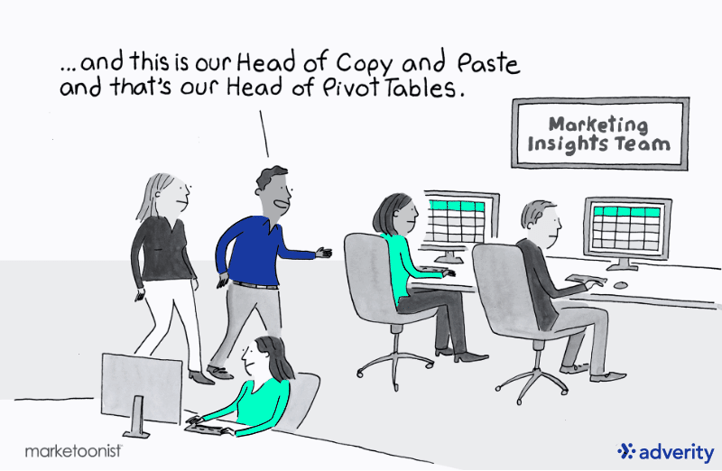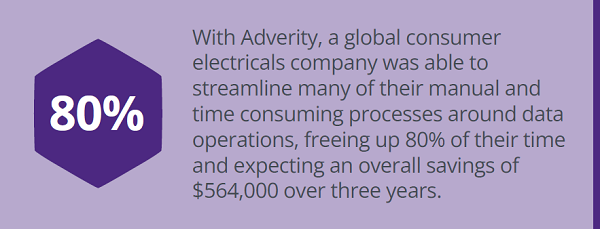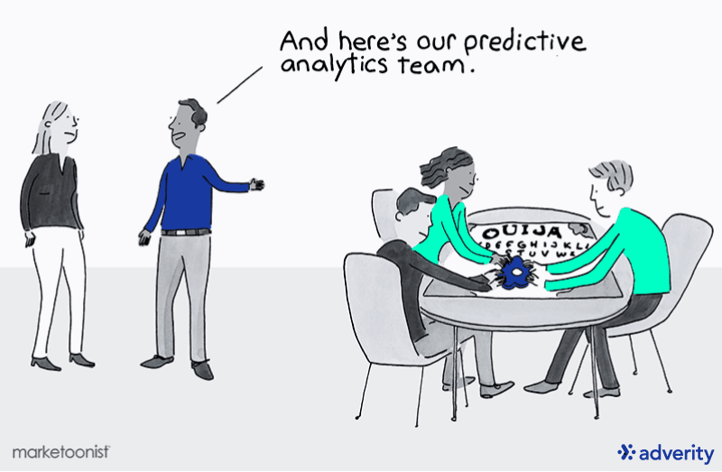Automated data integration might not sound like the most scintillating topic — but it could make your life a lot easier.
Marketing teams have long understood that data is a valuable resource, and today we have plenty of evidence that becoming more data-driven delivers better business performance. However, if you don’t have the right tools in your arsenal to deal with the increasing volume and complexity of data out there, then it’s easy to find yourself buried under a mountain of marketing data.
“Marketing analysts are data experts — they have plenty to offer your team, but they can’t do it if they’re drowning in data,” says Harriet Durnford Smith, CMO at Adverity.
The good news is that with increasingly sophisticated martech hitting the market, the move towards data-driven marketing doesn’t have to be a headache.
Marketing analysts have plenty to offer your team, but they can’t do it if they’re drowning in data
Harriet Durnford-Smith, CMO, Adverity
For any marketing analysts out there who are still on the fence about automating data integration, here are the top five reasons you should take the plunge.
1. Less time spent cleaning and combining data for reporting
One recent report found that 58% of marketing teams build their routine reports manually on spreadsheets. So it’s no wonder that time spent on manual data cleaning and integration for reporting was the top challenge for analysts in 2021. 42% said they struggled with this.
Finding martech that can take on this painstaking process means you can spend much less time on mundane tasks like getting data in one place for reporting or analysis.

A recent study found that one global consumer electricals company was able to automate their manual and time-consuming processes around data operations, freeing up 80% of their time.
2. More free time to create value
Ever feel like you spend so much time getting data in one place, that you hardly have time to analyze it?
All too often, marketing teams will hire an analyst who has extensive knowledge of sophisticated analytics, and then fill their time mind-numbing data cleaning and combining tasks. Data experts have much more to offer the marketing team, but it’s not going to happen unless the C-suite invests in taking the mundane data wrangling tasks off your plate.

You can let them know that it’s worth their while too. The consumer electricals company I mentioned earlier didn’t just get back 80% of their time. Letting analysts focus on actual data analysis rather than manual data cleaning and integration translated to overall savings of $564,000 over three years.
3. Optimized ad spend
Slow data analysis means slow decisions. If you can see how different channels are performing in a matter of minutes, you can act on those insights and optimize campaigns much more quickly. This means spotting opportunities for channels that are performing well and giving them a boost, but it also means catching anomalies like a huge spike in CPC for certain adwords. By catching these kinds of budget drains early on, you can avoid wasted ad spend.
But if it takes three days to copy and paste data into spreadsheets, those insights are going to be outdated by the time you actually act on them. In short, slow data analysis leads to wasted ad spend, and ultimately, losing out to competitors.
So what does that mean in terms of cold hard cash? A recent study found one consumer electricals company made $2.9 million in ad spend savings over three years due to timely insights on performance.

“We were doing marketing in the dark,” said the head of marketing insights and performance, “we had spreadsheet-based reporting, which is like looking in the rear mirror at what happened last month, but we were not able to look forward and steer.”
4. More accurate data
As the old adage goes, garbage in, garbage out. If your data isn’t accurate, the insights you get from it could end up doing more harm than good. 41% of analysts say they don’t trust their data. This is a major issue that needs to be addressed before marketing teams can claim to be data-driven.
A big part of this is getting rid of manual processes which open data up to human error. Recent research found that analysts who struggle with manual data integration are nearly four times as likely to struggle with data accuracy.
5. Job satisfaction
Let’s face it, nobody really wants to spend hours doing data cleaning and integration for routine marketing reports. So what do analysts really want to be doing? One recent study found that in the next 12 months, 69% of analysts want to introduce predictive modeling. Despite most of these marketing teams lacking some very basic requirements to take this step, predictive analytics is number one on analysts’ wish lists.

Your employers want to get value out of you, and any company worth its salt wants you to have a good experience working there. This is especially important in the face of the great resignation. The US saw 20 million resignations handed in over the course of last spring and summer, and one recent survey found that a shocking 60% of marketers were planning a job switch in 2021.
Wasting the time of skilled analysts with mundane tasks means unhappy employees
Harriet Durnford-Smith, CMO, Adverity
“Wasting the time of skilled analysts with mundane tasks doesn’t just mean wasted work hours - it also means unhappy employees,” says Harriet Durnford Smith, CMO at Adverity. Talented analysts aren’t going to stick around to copy and paste data into spreadsheets day in day out.
Conclusion
The modern marketing analyst shouldn’t be taking on jobs that are easily automated. Their skill set goes far beyond cleaning and combining data, but if marketing teams are going to get value out of their analysts, then streamlining these basic data-ops tasks is critical.










